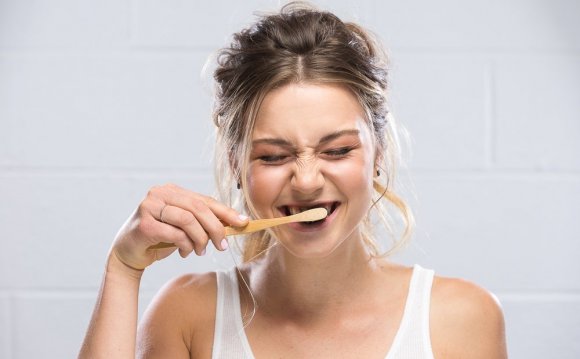
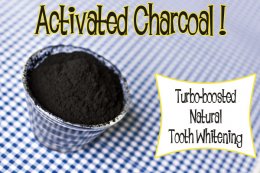 Today, I’m going to tell you to put charcoal on your teeth to whiten them.
Today, I’m going to tell you to put charcoal on your teeth to whiten them.
ONLY I DON’T MEAN REAL CHARCOAL, PEOPLE.
We have to get this out of the way – at the very beginning – so that no one reads the first four lines and goes, “Okey-dokey, Jimbo, open up that thar bar-BE-que ‘n let me fish out a brick ‘n shove it in meh mouth. Crunchy Betty said to.”
I DID NOT SAY TO DO THAT.
Stop it.
We’re not talking about charcoal. We’re talking about activated charcoal. Huge difference. And if you don’t know it, you should definitely read on. Before you wobble over to the barbeque and end up with a mouth full of stinky soot.
We’re clear, right? Not “charcoal” – but activated charcoal for teeth whitening. Right! So, let’s keep going. And it goes a little something like this:
Never before I have regretted not taking “before” pictures so much. See, I started using activated charcoal to whiten my teeth about three weeks ago, as an afterthought. After reading this article, my bag full o’ blackness had sat on my counter for a month out of my lumpy laziness, and one day I just dumped a little in my mouth and held it there. Just to see what happened.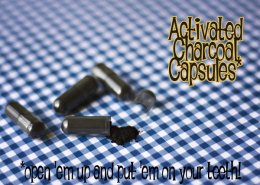 You know, experiments and all.
You know, experiments and all.
IMMEDIATELY, there was whitening. Immediately, after rinsing out all the black.
I was hooked. But not convinced.
For the first two weeks, I did this religiously, every night after brushing my teeth. My teeth are whiter than they’ve been since I was a teenager. For the last week, I’ve only done it three times. I’m thinking even two times a week as a “maintenance dose” will be perfect.
So, instead of showing you a before picture of my dingy before coffee-stained teeth, I’ll give you one better. Me, with activated charcoal IN MY MOUTH. Just keep learning, and you’ll get to the awesome, flattering picture.
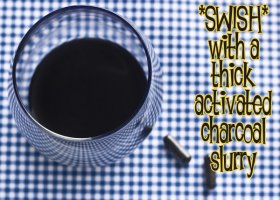 Activated Charcoal – Why It Works to Whiten Your Teeth
Activated Charcoal – Why It Works to Whiten Your Teeth
Before I tell you why it does this, let’s talk about what the difference between and regular charcoal (or even just burned stuff) is.
Regular charcoal – and we’re even talking about those burned up chunky logs in your fireplace – contains a whole host of impurities. It’s not as porous, and it’s pretty disgustingly covered with stuff you wouldn’t want to put in your mouth. Ever. Blech.
Activated charcoal (also called ) on the other hand, is really just charcoal (burned stuff) that’s been treated with a few gasses to purify it completely and turn it into a powerhouse of porous material that sucks in impurities from the environment around it.
This “sucking in” is a very rough way to describe what it actually does, which is adsorb materials. Adsorption is different than absorption, and what it basically means is that the porous surface of activated charcoal attracts (mostly unwanted) material a bit like a magnet and holds it in its pores. This leaves the area around it clean.
Activated charcoal isn’t just used for teeth whitening, though. It’s stocked in many emergency rooms, ready for people who’ve overdosed on things like drugs and alcohol. In fact, you should never, ever take activated charcoal with your prescription medication, because it WILL render your medication inert and totally useless.
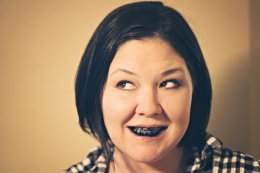 Any good water filter will use activated charcoal as one of its filtering methods. AND, it’s a pretty well-known home remedy for avoiding a hangover if you sail a little close to three sheets to the wind (but you have to take it before you go to bed, or it won’t work).
Any good water filter will use activated charcoal as one of its filtering methods. AND, it’s a pretty well-known home remedy for avoiding a hangover if you sail a little close to three sheets to the wind (but you have to take it before you go to bed, or it won’t work).
Many people take activated charcoal often, to “detox, ” but the jury’s still out on whether or not it also adsorbs things like vitamins and vital nutrients, so – personally – it’s not something I would take internally on a regular basis.
But how does it work on your teeth?
The answer is: Activated charcoal LOVES tannins.
And tannins (found in MANY foods, coffee, tea, wine, etc., and ad nauseum) are typically what cause staining and dinginess of the enamel of your teeth. It loves the tannins, and the tannins love it more than they love your teeth, so off they’ll go. Hopefully.
However, and here’s the good part, activated charcoal doesn’t adsorb the calcium salts tooth enamel is made of. It’s almost like it was made to whiten. And brighten. And do no harm.
So How Are You Going to Whiten Your Teeth With Activated Charcoal?
If you do some hunting and pecking, you might be able to find some toothpastes that still use activated charcoal as an ingredient. .
However, I have a feeling that with the hubbub about hydrogen peroxide as a tooth whitener, and the fact that it doesn’t look as mind-numbingly scary as activated charcoal in your mouth, the charcoal wasn’t as easy to market, so the idea died out a little.
If you can get yourself past the weird mouth look as you’re treating your teeth, you’ll be just fine. Activated charcoal is far less potentially irritating to your gums than hydrogen peroxide. And it’s not as tough on your mouth, in total. Plus, you might get a little tongue detox going on, as your tongue is a place that tends to hold quite a few toxins, if you’re not careful.









